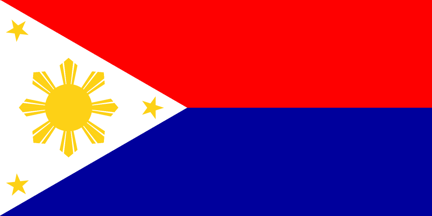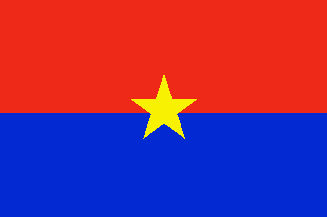OF SEEING THE FLAG AS AN EMBLEM OF ANTI-IMPERIALIST STRUGGLE
(Or OF SEEING THE FLAG AS AN INSPIRATION FOR THE INSURRECTION)
(Or OF SEEING THE FLAG AS AN INSPIRATION FOR THE INSURRECTION)

Flag of the Philippines with the Red on top to signify war,
but it may reinterpret again as a symbol of anti-imperialist struggle


We use to look at the TV set or in every part of our community a flag famous for its struggle against the Spaniards and the Americans, as well as a badge of patriotism inspired by every people involved in its fight.
However,
Not all things within that flag was and is well discussed. To others, it was a flag associated with freemasonry (like Andres Bonifacio and Emilio Aguinaldo) since it's design and symbol are well connected to the Jacobin ideals of Liberty, Equality and Fraternity while some said that was connected much to the geography, especially the sun and stars wherein aligned with the provinces and other places affected by colonial oppression and native struggles against the oppressor; white, blue and red may signifies cleanliness, blood and justice or even resembles a debt of honour to the almighty United States since Aguinaldo at first supported them during the Spanish-American war, not knowing its imperialistic plans towards the nation at that time.
But despite different interpretations, the Philippine flag resembles the ideals of patriotism and of independence made by the Filipino people alongside the red flag as the banner of the revolution. Most people perhaps may say that the flag symbolizes blood and honour and at the same time land and liberty due to the revolutionary ideals of the people at that time, and not of a "for sake" stance of adding color to the flag just to show recognition as a movement. The flag somehow also shows the methaphysical side wherein it is somewhat inspired by the anting-antings and agimats worn by the Katipuneros to ward off bullets. And the stars forming the triangle in the flag may also symbolizes or substitutes the KKK (just like the stamp used by the first republic) while the sun pertains to liberty (like the original flag); and the colors may resemble martyrdom in the land (Red) and seas, skies (Blue) covering the entire nation then in revolt.
Stamp of Aguinaldo's Philippine Republic,
wherein the KKK was still featured
wherein the KKK was still featured
In addition to that,
The flag, especially with a revolutionary past, may have been a part of the 20th century struggles in Asia, or perhaps an inspiration; especially like the colors Red and Blue or even the yellow star like the flag of the Vietcong during the war in Vietnam, wherein it shows a bit similarity with our flag, but with the red on top, with a different interpretation signifying the unity of the Red north and the Blue south under patriotism, democracy and socialism. And perhaps some Filipinos may disagree upon what I have said despite seeing this flag and shows how similar it was.
But then, Despite all events throughout the years, people may have tried much in seeking the anti-imperialist interpretation of the flag, not just the mere patriotic ones as what bourgeois-liberals may have said, but of the ones interpreted by people whose love of country includes love of people and faithfully serving them; like the Cuban flag whose roots were coming from anti-imperialist and popular-patriotic heroes like Marti-who even spoke a warning against America and its attempt to use Cuba after being liberated from Spain! But despite of that, Marti's influence were mostly of a liberal type, but then, he influenced every patriot including socialists like Commandante y Jefe Fidel; same as here like don Belong de los Reyes and Don Crisanto Evangelista. They are both Filipino revolutionaries, but they also became Marxists, or even Andres Bonifacio whose readings may include mob violence aside from Jacobin-Liberal inclined writings.
For me,
These shows that despite different interpretations especially of banners with similarities, I think that the Philippine experience may have influenced other struggles in Asia, primarily in the southeast. From the day Sun Yat-Sen supported Ponce, of Laurel tried to join the Indonesian freedom fighters to a float featuring a Viet-Cong warrior during the lantern parade in UP Diliman, all of these shows that how progressive leaning and freedom loving Filipinos are willing to support liberation struggles and even socialism, all despite countless oppression made by domestic and foreign enemies and slanderers of the people.
For me,
These shows that despite different interpretations especially of banners with similarities, I think that the Philippine experience may have influenced other struggles in Asia, primarily in the southeast. From the day Sun Yat-Sen supported Ponce, of Laurel tried to join the Indonesian freedom fighters to a float featuring a Viet-Cong warrior during the lantern parade in UP Diliman, all of these shows that how progressive leaning and freedom loving Filipinos are willing to support liberation struggles and even socialism, all despite countless oppression made by domestic and foreign enemies and slanderers of the people.





